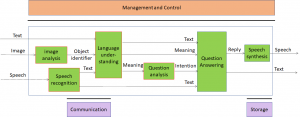This post attempts to answer some of the most frequent questions received on the proposed ISO Data Compression Technologies Technical Committee (DCT TC). See here and here. If you have a question drop an email to leonardo@chiariglione.org.
Q: What is the difference between MPEG and DCT?
A: Organisation-wise MPEG is a Working Group (WG), reporting to a Subcommittee (SC), reporting to a Technical Committee (TC), reporting to the Technical Management Board (TMB). Another important difference is that a WG makes decision by consensus, i.e. with a high standard of agreement – not necessarily unanimity – while a TC makes decisions by voting.
Content-wise DCT is MPEG with a much wider mandate than media compression involving many more industries than just media.
Q: What is special of DCT to need a Technical Committee?
A: Data compression is already a large industry even if one only looks at the single media industry. By serving more client industries, it will become even larger and more differentiated. Therefore, the data compression industry will require a body with the right attributes of governance and representation. As an example, data compression standards are “abstract” as they are collections of algorithms, and intellectual property intensive (today most patent declarations submitted to ISO are from MPEG). The authority to regulate these matters resides in ISO but the data compression industry will need an authoritative body advocating its needs because the process will only intensify in the future.
Q: Why do you think that a Technical Committee will work better than a Working Group?
A: With its 175 standards produced and its 1400 members, over 500 of which attend quarterly meetings, MPEG – a working group – has demonstrated that it can deliver revolutionising standards affecting a global industry. DCT intends to apply the MPEG successful business model to many other non-homogeneous industries. Working by consensus is technically healthy and intellectually rewarding. Consensus will continue to be the practice of DCT, but policy decisions affecting the global data compression industry often require a vote. Managing a growing membership (on average one member a day joins the group) requires more than an ad hoc organisation like today. The size of MPEG is 20-30 times the normal size of an ISO WG.
Q: Which are the industries that need data compression standards?
According to Forbes, 163 Zettabytes of data, i.e. 163 billion Terabytes, will be produced worldwide in 2025. Compression is required by the growing number of industries that are digitising their processes and need to store, transmit and process huge amounts of data.
The media industry will continue its demands for more compression and for more media. The industries that capture data from the real world with RADAR-like technologies (earth-bound and unmanned aerial vehicles, civil engineering, media etc.), genomics, healthcare (all sorts of data generated by machines sensing humans), automotive (in-vehicle and vehicle-to-vehicle communication, environment sensing etc.), industry 4.0 (data generated, exchanged and processed by machines), geographic information and more.
Q: What are the concrete benefits that DCT is expected to bring?
A: MPEG standards have provided the technical means for the unrelenting growth of the media industry over the last 30 years. This has happened because MPEG standards were 1) timely (i.e. the design is started in anticipation of a need), 2) technically excellent (i.e. MPEG standards are technically the best at a given time), lively (i.e. new features improving the standard are continuously added) and 4) innovative (i.e. a new MPEG standard is available when technology progress enables a significant delta in performance). DCT is expected to do the same for the other industries targeted by DCT.
Q: Why should DCT solutions be better than solutions that are individually developed by industries?
A: “Better” is a multi-faceted word and should be assessed from different angles: 1) technical: compression is an extremely sophisticated domain and MPEG has proved that relying on the best experts produces the best results; 2) ecosystem: implementors are motivated to make products if the market is large and sharing technologies means that implementors face a lower threshold to enter. ON the contrary a small isolated market may not provide enough motivation to implementors; 3) maintenance: an industry may well succeeds in assembling a group of experts to develop a standard. However, a living body like a standard needs constant attention that can no longer be provided if the experts have left the committee; 4) interoperability: industry-specific data compression methods are dangerous when digital convergence drives data exchange across apparently unrelated industry segments because they create non-communicating islands.
Posts in this thread (in bold this post)
- The MPEG ecosystem
- Why is MPEG successful?
- MPEG can also be green
- The life of an MPEG standard
- Genome is digital, and can be compressed
- Compression standards and quality go hand in hand
- Digging deeper in the MPEG work
- MPEG communicates
- How does MPEG actually work?
- Life inside MPEG
- Data Compression Technologies – A FAQ
- It worked twice and will work again
- Compression standards for the data industries
- 30 years of MPEG, and counting?
- The MPEG machine is ready to start (again)
- IP counting or revenue counting?
- Business model based ISO/IEC standards
- Can MPEG overcome its Video “crisis”?
- A crisis, the causes and a solution
- Compression – the technology for the digital age
- On my Charles F. Jenkins Lifetime Achievement Award
- Standards for the present and the future


